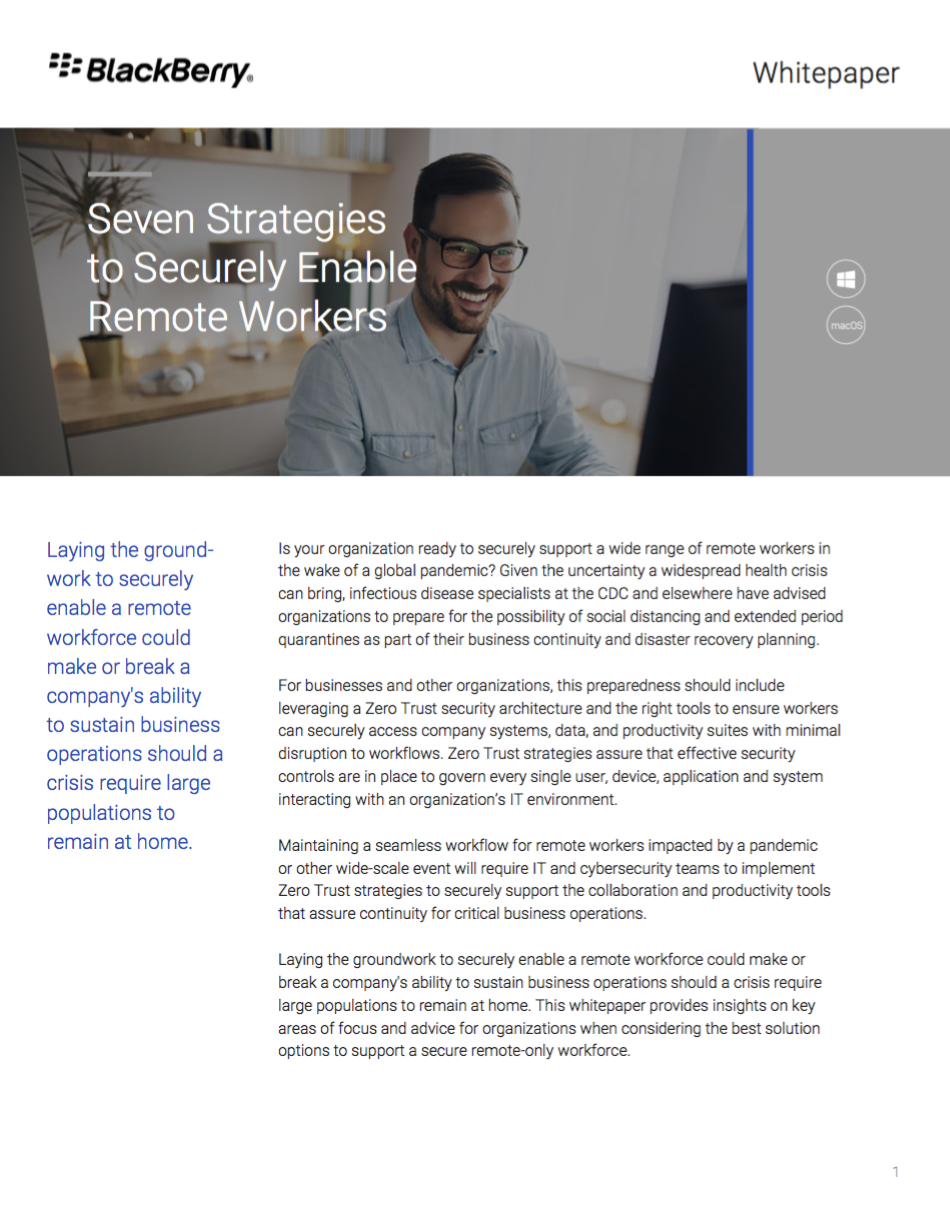What does the future of work look like?
How remote working, automation and AI will affect the way we work

Advancements in technology are rapidly transforming the modern workplace, whether that's through mobile hardware such as tablets, hybrids and smartphones, or software in the form of collaboration and video conferencing tools that make it possible for employees to work together as if they're in the same room.
A key consideration when thinking about the future of the workplace is the role of automation and how this will transform the nature of our current job roles. For example, some customer services may be replaced with AI that can identify a customer's problem using voice and context recognition and find a solution without a human even being involved.
As well as this, business intelligence and AI will help companies learn more about their customers, so employees can focus on innovation to transform their businesses.
Will there be a physical office?
In this digital era of email, virtual meetings and collaboration tools, it is easy, convenient and often more productive to work remotely. Employees are more motivated and managers find their workforce is more likely to come up with innovative ideas as they increasingly have the opportunity to pursue new avenues.
Last year, 64% of organisations offered a flexible working environment, 21% higher than the year before, which suggests that providing the tools to work remotely is high on the list of priorities for many businesses.
The shift towards remote working means physical workplaces are changing to accommodate this. Some companies are downsizing their office space, providing open plan desks with monitors and workstations that can be used by anyone. A "first-come, first-served" policy means those who arrive first can choose where they want to work, while those who are late to the party may need to find space in alternative areas.
In this way, the contrast between the future of work and work in the present day is most visible. Consider the skyscrapers dominating skylines, down to the warehouses renovated by businesses as they clamber to accommodate growth in personnel. Then imagine that half of the employees taking up space in these buildings are suddenly not there.
Sign up today and you will receive a free copy of our Future Focus 2025 report - the leading guidance on AI, cybersecurity and other IT challenges as per 700+ senior executives
That will be the case by 2025, according to a session delivered at KMWorld 2019. A surplus of space will be seen as an opportunity to cut costs, potentially leaving offices across the globe vacant.
RELATED RESOURCE

Seven strategies to securely enable remote workers
Sustain business operations during a crisis by following these strategies
What devices will be used?
In fact, even the devices we use in the workplace will most likely be very different in the future. Workers were traditionally dependent on office-based computers, but now want more options about what devices they use and where they use them. A survey into mobile access revealed that 43% of business professionals see the use of mobile phones as critical for work, enabling them to use apps and work tools on the go.
By 2025, it is estimated that over 75 billion devices will be connected to the internet and to each other, generating an expected 79.4 ZB. Many of these will be strictly for personal use, and many will be dedicated solely to work. However, a significant portion are hybrids, used for both work and play.
This brings a different set of challenges for IT departments who will have to look into appropriate tools and software to enable flexibility, whilst also considering security concerns and other issues that remote and on-the-go working open up.
Using virtualisation tools, employees can access their files, folders and networked services such as the intranet either on shared devices, or their own machines they bring from home, while collaboration tools such as Slack and Skype mean workers can communicate with other team members working remotely whenever they need to.
How might automation change the future of work?
Automation’s thrust into the workplace is a double-edged sword, with developing technologies such as RPA playing a key role in reshaping the way tasks are performed. In this example, RPA is able to complete predictable, often mundane tasks in a fraction of the time it takes a human, and with zero errors. This equals efficiencies for employers, however, can leave staff at risk.
The Office of National Statistics states that almost 8% of jobs in the UK are at high risk of automation, with some or all of their duties and tasks set to be automated. In the following decades, Deloitte’s expect this figure to rise dramatically to 35%.
A McKinsey study found that the industries and job roles most likely to be affected by automation are predictable physical work, with 78% of the role's tasks possible to automate by adapting currently demonstrated technology, data collection (69%), and data processing (64%).
Deloitte found that middle-income jobs are most at risk, with UK jobs with wages of 30,000 or under being five times more susceptible to AI automation than jobs paying upwards of 100,000.
Fortunately, many endangered employees view automation as an opportunity over a threat. Liberated from the shackles of mundane, repetitive tasks, they can upskill to focus on more engaging, higher-value tasks. New skills can be acquired that are much harder to automate, such as people-orientated roles, helping to plug gaps in organisations while also future-proofing themselves.
In fact, the government has pledged to support workers displaced by automation. The National Retraining Scheme is designed in association with the Confederation of British Industry and the Trades Union Congress and aims to help workers retrain if they are displaced by automation or other emerging technologies.
This means that to ensure survival the future workforce will have to constantly adapt and embrace reskilling, collaborating with intelligent machines, as well as managing and supervising the tasks they perform.
How will business intelligence change the way we work?
Closely related to automation, business intelligence will also have an impact on the way we work. Business intelligence (BI) is a term used to encompass multiple disciplines, from collecting and storing data to manipulating and interpreting it in a way that can be used to make business decisions.
Business intelligence can make companies more competitive by crunching data about their business units to find efficiencies and deploy resources more effectively. Collecting and analysing data about the way customers think, and turning this information into key insights, can also help them target customers better.
One example of an effective use of business intelligence tools is in customer analysis. BI can be used to analyse what consumers want and come up with ways to satisfy these expectations, guiding business strategy in a much more informed way. This, in turn, means companies can focus on innovation rather than trying to work out what their customers want, offering a much better informed and on-target plan.
Business intelligence tools will increasingly become an essential part of a company's infrastructure, because without these insights, businesses will fall behind competitors who are acting on this information.
RELATED RESOURCE

Seven strategies to securely enable remote workers
Sustain business operations during a crisis by following these strategies
What are the consequences of a changing workplace?
Many of the changes currently taking place in the workplace will result in a dramatic shift in the future of work, as well as what the office of the future will look like. More people will work remotely, giving them a better work/life balance. Collaboration tools will also make companies more productive, with employees able to share knowledge and work together on goals regardless of geographic obstacles.
But for this type of workplace to be able to succeed, the right tools need to be in place for employees to be able to operate remotely and collaborate effectively. This means businesses need to ensure they have the right technologies and skills in place as part of an ongoing digital transformation strategy. This can lead to problems for companies that move at a slower pace, as processes and systems can quickly become outdated.
The development of automation is more tricky. On the one hand, it will certainly lead to more efficient processes for companies, speeding up the act of data collection and even analysis to provide more fruitful insights that humans can act on.
But increased automation will also likely result in redundancies, at least in the short term, and there needs to be serious efforts to help people retrain if they are to find jobs that are less at risk from automation.
-
 Gender diversity improvements could be the key to tackling the UK's AI skills shortage
Gender diversity improvements could be the key to tackling the UK's AI skills shortageNews Encouraging more women to pursue tech careers could plug huge gaps in the AI workforce
-
 Researchers claim Salt Typhoon masterminds learned their trade at Cisco Network Academy
Researchers claim Salt Typhoon masterminds learned their trade at Cisco Network AcademyNews The Salt Typhoon hacker group has targeted telecoms operators and US National Guard networks in recent years
-
 Alteryx names former Salesforce, Oracle strategist as new global technology alliances lead
Alteryx names former Salesforce, Oracle strategist as new global technology alliances leadNews The former Salesforce and Oracle leader will spearhead Alteryx’s partner strategy as the vendor targets deeper ecosystem collaboration
-
 "There is a pressing need to address 'technostress' head-on" – Knowledge workers stressed and anxious thanks to tech
"There is a pressing need to address 'technostress' head-on" – Knowledge workers stressed and anxious thanks to technews Notification overload and platform juggling leave many looking for a new job
-
 'Digital hide-and-seek': Workers are wasting hundreds of hours a year sourcing the information they need to carry out their role
'Digital hide-and-seek': Workers are wasting hundreds of hours a year sourcing the information they need to carry out their roleNews Knowledge workers globally are wasting a quarter of their working week tracking down information, new research from Atlassian has revealed.
-
 Untethered: How CIOs and CISOs are paving the way for the new hybrid workforce
Untethered: How CIOs and CISOs are paving the way for the new hybrid workforceWhitepaper Effective techniques to transition from exposed legacy infrastructure to an effective zero trust strategy
-
 Essential skills for managers: Develop resilient employees
Essential skills for managers: Develop resilient employeesWhitepaper Build team culture, no matter where your people are located
-
 The GenAI transformation: Perspectives on leadership
The GenAI transformation: Perspectives on leadershipWhitepaper Guide employees through a generative AI transformation
-
 2024 Global learning & skills trends report
2024 Global learning & skills trends reportWhitepaper Top trends for the future of work
-
 Reimagining leadership development for today’s workforce
Reimagining leadership development for today’s workforceWhitepaper Top trends for the future of work

